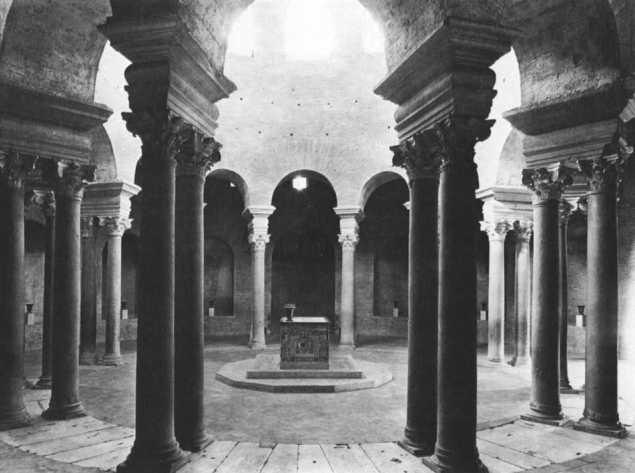Rotunda of Sta. Costanza. Rome, about 337-351
The rotunda called “Sta. Costanza'' was the mausoleum of the princess Constantina (d. 354), a daughter of Constantine the Great. It adjoined an immense basilica dedicated to the virgin Agnes, whose tomb was in a nearby catacomb. The siting is typical of Christian mausolea, for it was believed that burial near a martyrium would encourage the martyr's intercession for one's soul. The basilica has long been a ruin, but the mausoleum, now a church, still stands.

Sta. Costanza descends from the domed, centralized type of tomb used by the Tetrarchs (nos. 104, 107), but in it the type has been dramatically reformulated. The dome has been dissociated from the solid bounding walls; it rests instead on an inner ring of twenty-four paired columns. The interior is thereby diversified, and the central domed space, brilliantly lit by large windows under the cupola, is set off by the shadowy ambulatory. The ambulatory contains the traditional wall niches, but there are many more than usual and they are differentiated in size. The princess' sarcophagus once stood before the large south niche, under a small tower that interrupts the ambulatory's barrel vault; the sarcophagus is now in the Vatican Museum.
Like her father's audience hall in Trier (no. 102), Constantina's mausoleum has a subtly meaningful design. The windows under the dome number twelve, like the apostles, who illuminated the world with Christianity. In the circular arcade, the four intercolumniations aligned with the axial niches were made slightly wider and their arches slightly higher than those in between, marking a cross. The sarcophagus stood within the cross, in its south arm.
The decoration, once elaborate, is mostly lost, but it was recorded in several drawings of the Renaissance. Concave surfaces—dome, barrel vault, niches—were covered with mosaic, while the vertical face of the drum over the arcade was masked with opus sectile simulations of pilasters, cornices, and other architectural motifs. The mosaics included many Christian representations: scenes from the Old and New Testaments in the cupola, and images of Christ in the tower and niches. They were juxtaposed to caryatids and purely secular river views in the cupola, and to cupids, nymphs, and scenes of vintage in the ambulatory. The abundance of profane motifs fostered the opinion that Sta. Costanza was created as a temple of Bacchus, which accounts for its popularity in the Renaissance. In fact, Sta. Costanza demonstrates how surprisingly large was the repertoire of pagan ornamental motifs that could be harmoniously employed in Christian art of the mid-fourth century. Bibliography: Deichmann and Tschira, 1957, pp. 81 ff.; Stern, 1958; Strong, 1960; Frutaz, 1969, pp. 72-83; Toynbee, 1971, pp. 160-161.
Date added: 2025-08-01; views: 159;
